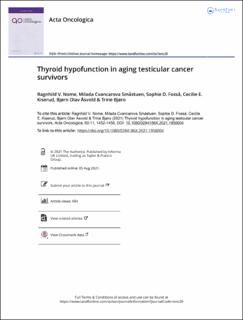| dc.contributor.author | Nome, Ragnhild V. | |
| dc.contributor.author | Småstuen, Milada Cvancarova | |
| dc.contributor.author | Fosså, Sophie D. | |
| dc.contributor.author | Kiserud, Cecilie E. | |
| dc.contributor.author | Åsvold, Bjørn Olav | |
| dc.contributor.author | Bjøro, Trine | |
| dc.date.accessioned | 2022-06-17T08:56:35Z | |
| dc.date.available | 2022-06-17T08:56:35Z | |
| dc.date.created | 2021-08-26T15:52:03Z | |
| dc.date.issued | 2021 | |
| dc.identifier.citation | Acta Oncologica. 2021, 1-8. | en_US |
| dc.identifier.issn | 0284-186X | |
| dc.identifier.uri | https://hdl.handle.net/11250/2999253 | |
| dc.description.abstract | Purpose Thyroid hypofunction is a late effect observed in several groups of cancer survivors, but has to date not been evaluated in-depth in testicular cancer survivors (TCSs). We investigated the prevalence of thyroid hypofunction in long-term TCSs and compared the findings with those of a comparison group from the general population. Patients and Methods Norwegian TCSs diagnosed with unilateral testicular cancer in the period 1980–1994 (N = 1,436) were grouped according to their cancer treatment (Surgery only; Radiotherapy only; Cisplatin-based chemotherapy, eventually combined with radiotherapy). They were invited to participate in three surveys covering up to three decades post-diagnosis. Serum thyrotropin (s-TSH) from samples collected from the last survey were analyzed. S-TSH results were also available from a health survey of the general population performed in a county in mid-Norway (the HUNT3 Survey [comparison group]). Data on the prescription of thyroid hormone replacement therapy (levothyroxine) from the Norwegian Prescription Database were obtained for the TCSs and the comparison group’s participants. Thyroid hypofunction was defined as ‘untreated’ (overt or subclinical) hypothyroidism (with s-TSH ≥3.5 mIU/L and no regular prescription of levothyroxine) or ‘treated’ hypothyroidism with regular prescription of levothyroxine. Results Three decades after diagnosis the prevalence of thyroid hypofunction (i.e., both treated and untreated) was 11% in the TCSs and the prevalence ratio was 1.9 indicating an almost doubled prevalence in the TCSs compared to the comparison group (prevalence ratio 1.91, 95% CI [1.54; 2.38]). However, there were no significant differences in the risk of thyroid hypofunction related to the TCSs’ treatment modality. Conclusion TCSs may have an increased prevalence of thyroid hypofunction compared to the general population. Hypothyroidism has negative consequences related both to primary hypogonadism and to cardiovascular disease. As both conditions are overrepresented in TCSs, regular monitoring of thyroid hormones may be advisable. | en_US |
| dc.language.iso | eng | en_US |
| dc.publisher | Taylor & Francis | en_US |
| dc.rights | Attribution-NonCommercial-NoDerivatives 4.0 Internasjonal | * |
| dc.rights.uri | http://creativecommons.org/licenses/by-nc-nd/4.0/deed.no | * |
| dc.title | Thyroid hypofunction in aging testicular cancer survivors | en_US |
| dc.type | Peer reviewed | en_US |
| dc.type | Journal article | en_US |
| dc.description.version | publishedVersion | en_US |
| cristin.ispublished | true | |
| cristin.fulltext | original | |
| cristin.qualitycode | 1 | |
| dc.identifier.doi | 10.1080/0284186X.2021.1958004 | |
| dc.identifier.cristin | 1929052 | |
| dc.source.journal | Acta Oncologica | en_US |
| dc.source.pagenumber | 1-8 | en_US |

